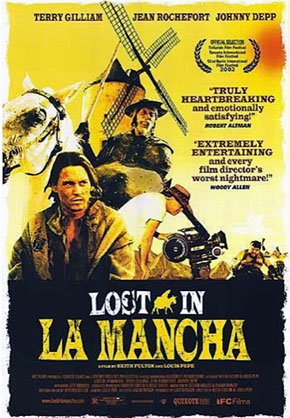
Baseball's Active Leaders, 2023
What Trump Said When About COVID
Recent Reviews
Everything Everywhere All at Once (2022)
Black Panther: Wakanda Forever (2022)
Doctor Strange in the Multiverse of Madness (2022)
Spider-Man: No Way Home (2021)
The Cagneys
A Midsummer Night's Dream (1935)
Something to Sing About (1937)
Angels with Dirty Faces (1938)
A Lion Is In the Streets (1953)
Man of a Thousand Faces (1957)
Never Steal Anything Small (1959)
Shake Hands With the Devil (1959)
Lost in La Mancha: The Un-making of Don Quixote (2003)
Throughout "Lost in La Mancha," a documentary detailing Terry Gilliam’s failed attempt to make a movie out of the Don Quixote story, almost everyone behind the scenes compares Gilliam, the maverick filmmaker responsible for "Brazil," with Cervantes’ Quixote. Both are romantics tilting at windmills.
Yet it’s elucidating to contrast the two men as well. Quixote, after all, was mad and Gilliam isn’t, and by that I don’t mean to be flip. Madness has been a part of Gilliam’s oeuvre from the beginning — think of his insane animations for "Monty Python’s Flying Circus" and Robin Williams’ mad dash in "The Fisher King."
More to the point: The best documentaries on disastrous filmmaking focus on directors close to the brink. There’s Francis Ford Coppola with a gun to his head in "Hearts of Darkness" and Werner Herzog with his thousand-yard stare in "Burden of Dreams." Gilliam, in contrast, is surprisingly subdued as his movie falls apart around him. One expects bangs out of him and gets only whimpers.
| Written by | Keith Fulton Louis Pepe |
| Directed by | Keith Fulton Louis Pepe |
| Starring | Johnny Depp Terry Gilliam |
In September 2000, Gilliam’s crew met in Spain to begin production on "The Man Who Killed Don Quixote," about a modern-day ad executive who finds himself magically transported to Cervantes’ universe to become Quixote’s Sancho Panza.
It was already a troubled project (are there other kinds?), but Gilliam had reason to be hopeful. He had his Don Quixote (the French actor Jean Rochefort), he had a major star (Johnny Depp as the ad exec) and, because he was financed solely with European money, he had creative control.
But six weeks before production, Phil Patterson, the first assistant director, said the film was in "complete disarray." The principal actors arrived late from other projects, and the sound stage was not soundproofed. Plus the shooting schedule was tight and left no margin for error.
Error happened. The first day of shooting occurred next to a NATO bombing range, and fighter planes periodically roared overhead, ruining scenes. On the second day, the skies darkened, then dumped rain and hail, and the tarp-covered equipment began to float away in a flash flood. Afterward, the blond desert had darkened and grown vegetation, rendering it useless for Gilliam’s purposes.
The death knell came on the fifth day when Rochefort fell ill with an enlarged prostate and returned to France. Word came back he wouldn’t be able to work for a week, then a month.
Interestingly, the previously mentioned "making of ... " documentaries had similar star problems. Coppola fired Harvey Keitel two weeks into filming "Apocalypse Now" and replaced him with Martin Sheen, who subsequently suffered a heart attack. Herzog’s original "Fitzcarraldo," Jason Robards, fell ill and was replaced by Klaus Kinski.
But Gilliam refused to replace his Quixote and thus doomed his vision.
"Lost in La Mancha" is funny and instructive, but less operatic than "Hearts of Darkness" and "Burden of Dreams" because the subjects of the other documentaries were actually completed. Here we’re left with only a few scenes — low-browed giants snarling and skipping — and thoughts of what might have been had Gilliam been as crazy as Coppola or Herzog ... or Quixote.
Originally appeared in the Fenruary 14, 2003 edition of The Seattle Times.
—January 11, 2015
© 2015 Erik Lundegaard







